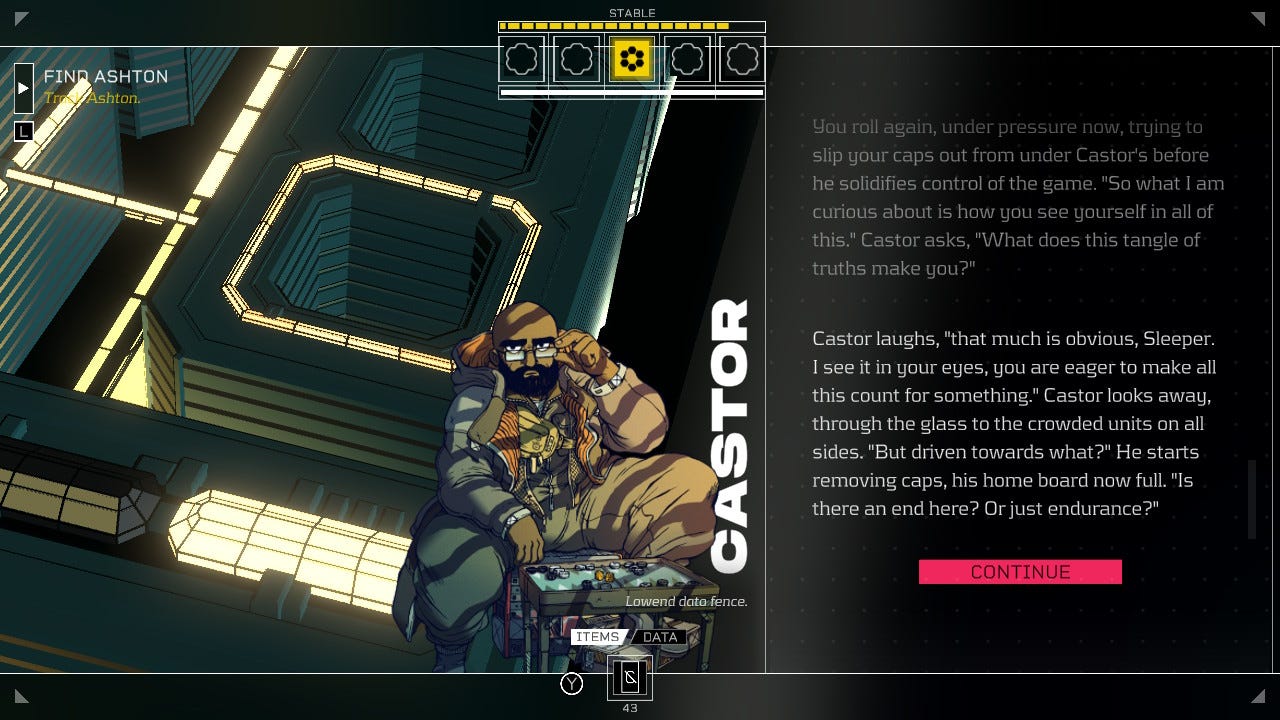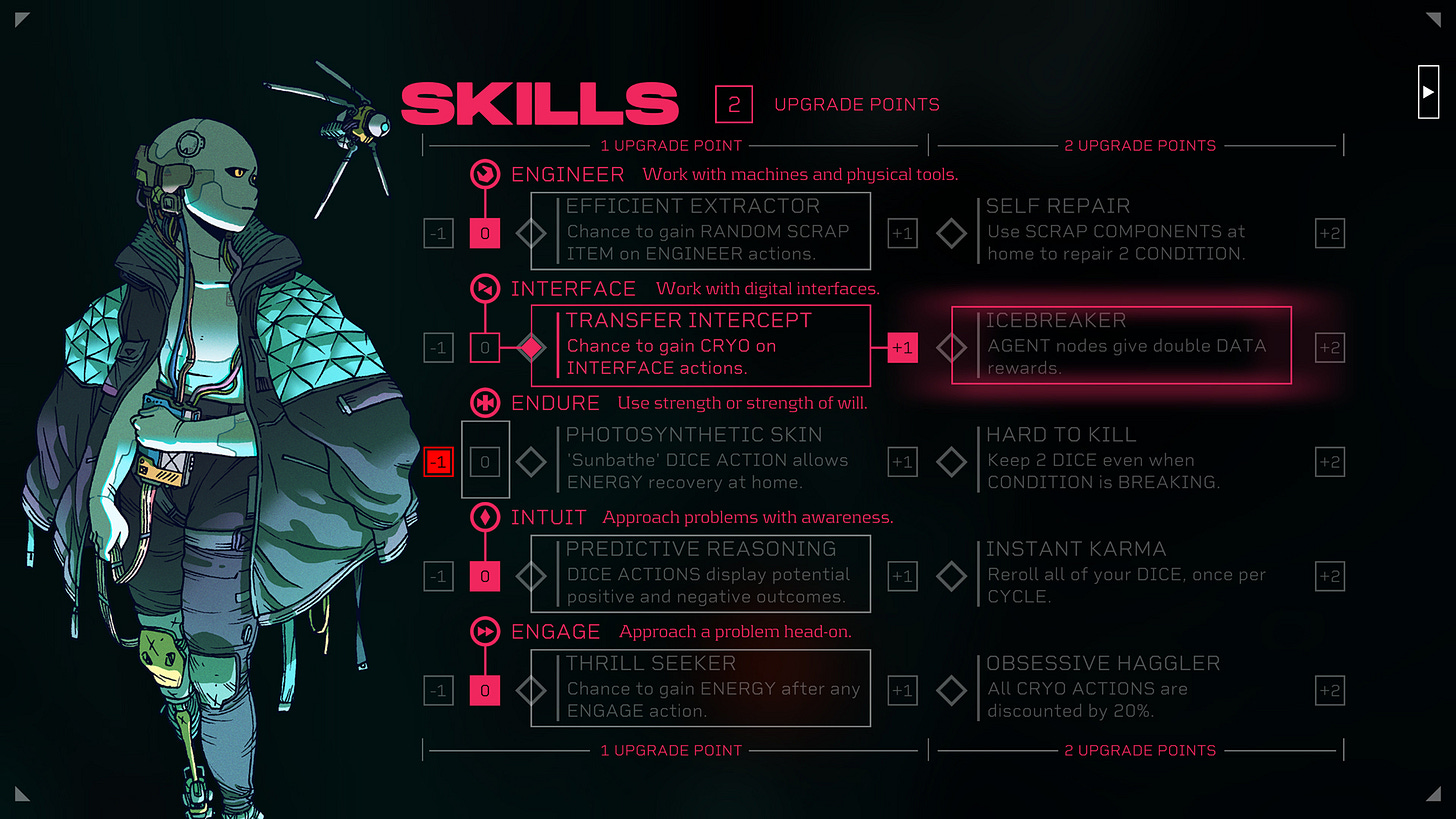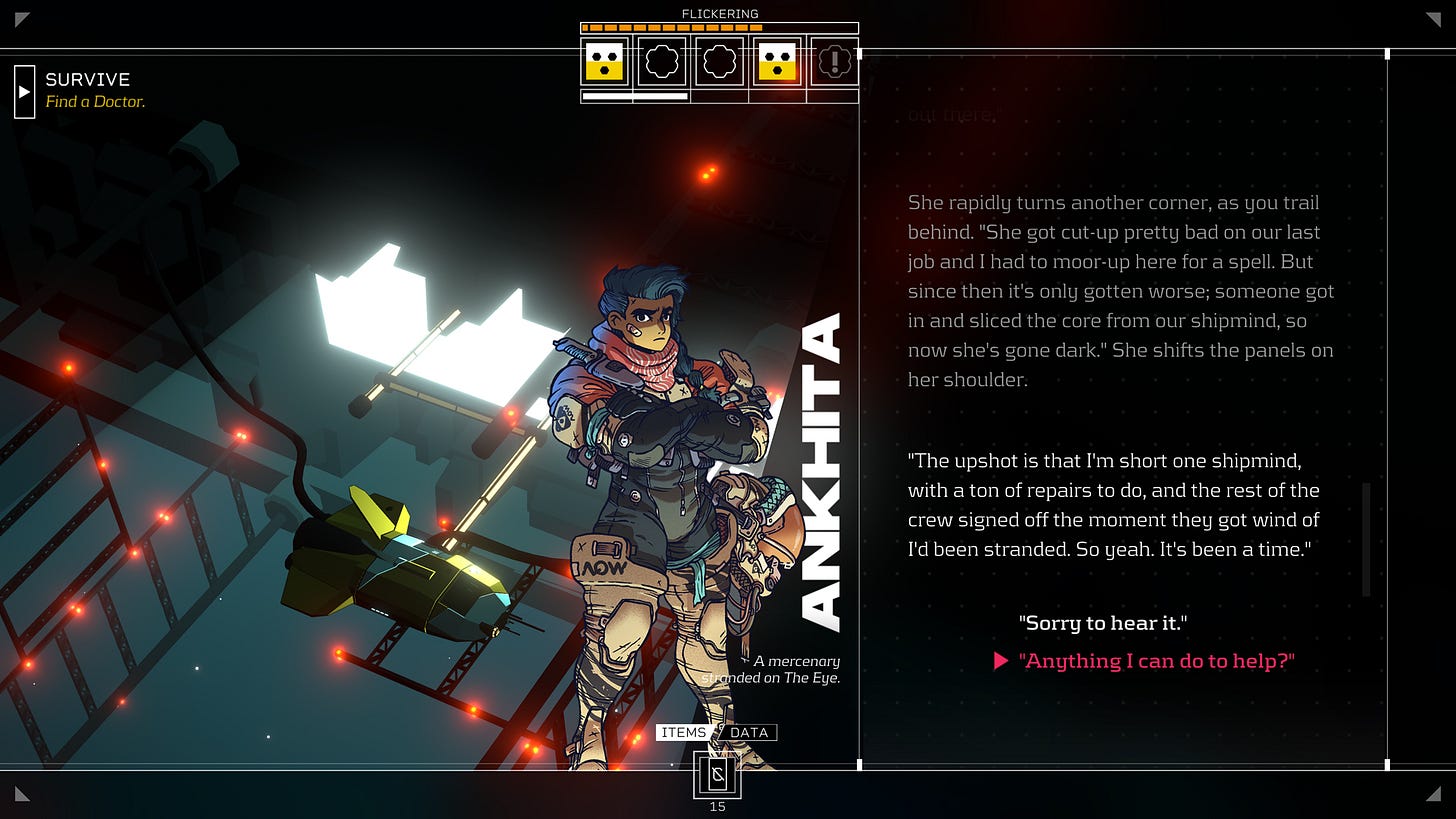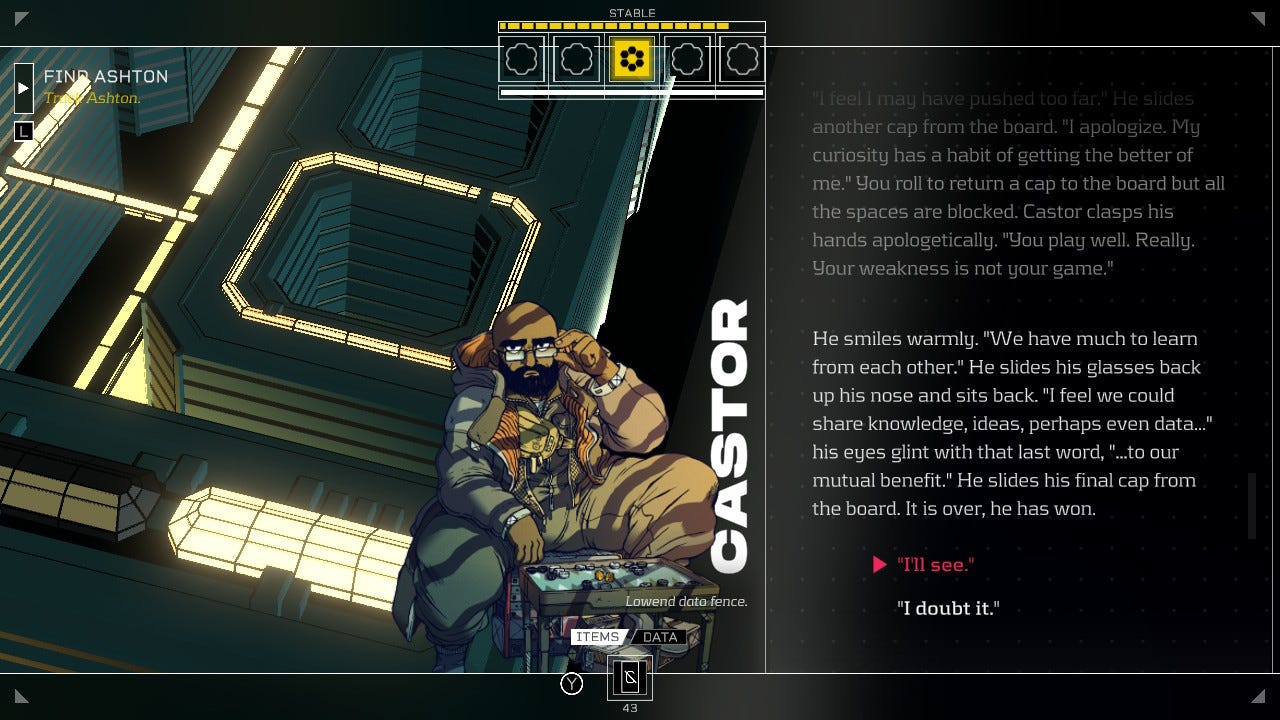This analysis of Citizen Sleeper includes a custom challenge run I created for myself. For a list of basic rules and suggestions for trying it out for yourself, skip to the bottom of the page!
My Sleeper is shy. When given the option, they will “Say nothing,” preferring action over talk.
Their uncanny ability of absorbing “damage,” has made them trusting. Some would say it’s made them naive. My sleeper will always comply the first time. When confronted by a shady figure to “Stop,” they will. When that figure puts a gun to their back, they won’t comply again.
Singular minded, my Sleeper is only concerned with survival and the survival of others. Particularly the survival of those they care about. If being silent isn’t an option, they will always choose the shortest answer, and, if possible, will avoid asking any questions to keep conversations short.
These are the sets of rules my Sleeper, a humanoid robot who’s sentience has been scanned and uploaded from a human to work off their debts, lives by.
We built a habit around these rules, my Sleeper and I, mechanically scanning and choosing the options which fit within the framework. Always choose to “Say nothing,” when available, avoid asking questions, choose the shortest answer, comply. That’s who we were. That is, until we met Castor.
Citizen Sleeper strips away the AAA spectacle from the modern RPG, offering a simplified aesthetic that emphasizes the core elements of a great RPG. The story and characters come to life in the imagination, aided by the expertly realized world and creative vision of Gareth Damian Martin. The character’s, who’s allegiances and motives seem always in flux are portrayed in glorious fashion by artist Guillaume Singelin. Each character portrait is a masterclass in character design, as each twist and turn in their stories and backstories will have you noticing new details on them as a sort of visual foreshadow. As for my number one most listened to album on Apple Music in 2022 (and top 5 of 2023), the soundtrack by Amos Roddy just bangs, and it’s implementation into the game itself is done in beautiful, controlled bursts. A lot of the time, the game is silent but for ambient sounds like children at play in a nearby apartment or the creaking of metal in a shipyard. But every once in a while, maybe during a conversation with a friend, Roddy’s soundtrack fades in. It captures life on the giant ring floating in space, Erlin’s Eye, with its sometimes harsh and metallic representation of the hyper (maybe not so) far-future capitalism with glimmers of hope that shine through like serene, calm piano melodies. These three elements, story, art, music, and their respective artists, come together in a game dev supergroup to deliver an RPG which foregoes the spectacle in favor of something more grand. It gives us the tools to wonder: what world can we imagine?
You’ll likely first meet Castor several days (called “cycles” in-game), into your playthrough. We’ve just had to make the tough decision to deliver a rare and valuable spaceship part to our friend Ankhita, a gruff mercenary who, after several cycles of helping her build her ship, seems to have come to trust us. It was tough in that we were only just barely able to secure one, but Ankhita wasn’t the only friend who needed it. NEOVEND, a mysterious sentient vending machine, also needed one. While we didn’t know much about NEOVEND, they offered help in a way only they could in exchange. Ankhita was very different than we were personality wise, but through those cycles of working together, we formed a bond. NEOVEND was the opposite. A machine, created to dispense goods and service by inserting money, no longer serving that purpose. We related to each other in that way.
Citizen Sleeper presents it’s relationships between the player’s Sleeper and the cast of characters in a minimalist way. The cycles we spent helping Ankhita are represented simply by a wheel. After our first interaction with her when she asks for our help, and we characteristically comply, we have the option to use our daily-allotted energy and resources, represented by dice, to help her fix her broken down spaceship.
As the wheel is filled, no extra scenes or lengthy dialogue plays out, but the player can assume and imagine for themselves the interaction that takes place when fixing up Ankhita’s ship. After completing the ship task and triggering Ankhita’s next dialogue scene, her tone is familiar and trusting. A relationship has formed since your first meeting, fully implied by a progress bar on a wheel, and hopefully imagined by the player.
What greater expression of player freedom is there than this? If you choose to help Ankhita, or NEOVEND, or Feng, anyone, the game assumes there is a reason for that and will drop you on the other side with a closer bond. Each cycle in between is yours to imagine. Perhaps one day while tinkering under the hood of the ship you dropped a tool deep into the complex machinery. While trying to get it out you noticed a rat living in the engine! You both spend the rest of the day trying to get the rat out, then as you unwind with a meal at the end of the day speculate as to how rats ended up on Erlin’s Eye in the first place. Ankhita jokes that there had to be something for the cats to play with. It was a nice night.
Such is the promise of the RPG. While choosing an option from a list that then plays out in glorious 4K, 120 frames may be satisfying— and in many cases fun— it does not evoke freedom. In the same way freedom to work any job I want to work towards is not the same as freedom to do as I please.
Of course, the game needs to exist as a guide to the player. Absolute freedom, in all cases, is a myth. Some think generative AI can give the player of a game absolute freedom, the game reacting to your every decision, uniquely tailored to your play style and character personality. This would be an impressive technical achievement but would still only serve as satisfying.
Imagine the same scene I described with Ankhita. You are helping her fix her ship one day and your actions are fully yours to determine and will play out in front of you. The game in turn will react. Where does dropping a tool come in? Is that a player decision or the game? What would cause the player to make that decision? “I accidentally drop my tool.” It could happen, but more likely would come from a failed check within the systems of the game. If the game makes the decision, is that ultimate freedom? Video games will always be in conversation with the player, not simply at their whims. We’ve introduced more restrictive mechanics here than we’ve erased: ability checks for specific actions, generative AI arbitrarily placing some kind of consequence for the dropped tool, potentially including combat with a rat, and all for the low price of $70-100 and the future of the Amazon rainforest. I like the progress wheel.
These imagination-based systems need not be relegated to the niche indie market either. Take for example one of the most highly regarded game studios making games today. With an almost perfect track record in their modern history, both commercially and critically, FromSoftware have built and entire genre around ambiguity. And I don’t mean the “Soulslike” video game genre. I mean the lore video YouTube genre. Dark Souls and it’s successors each leave just enough titillating breadcrumbs to pique the imagination. Their narratives offer just enough tangible elements to keep the player on track, but never enough for 100% certainty. Yet these lore videos are sometimes hours long, piecing together sparse factual details, strung together by imagination. The community may come to a consensus on a narrative, but there is always room for interpretation. And don’t forget, your player character, the Tarnished, has a role to play as well.
Castor asked us to sit before anything else. With no reason not to trust him yet, we did. We played backgammon and as we did, Castor spoke. He spoke plainly without judgement or bias about the nature of a Sleeper: a robot body, inhabited by the consciousness of a human. The human, set in a cryogenic sleep until the Sleeper works off the human’s debt, would be trapped there eternally since the Sleeper had escaped.
“What does this tangle of truths make you?”
Ankhita was robbed. That rare ship part stolen right out by someone, and Ankhita thinks she knows who did it. Without a second thought, we’re on the hunt for Ankhita’s former employee, Ashton. Our search brings us to a remote spot on Erlin’s Eye, across the Founder’s Gap to The Wastelands. Hot on Ashton’s trail, a gunshot rings out, and we tumble to the ground, taking cover. We make our approach with Ankhita, maneuvering around the deserted Wastelands through overgrown wildlife and debris when we see the other Sleeper, dying, weak, connected to the stolen ship part to survive. We had never seen another Sleeper like us before.
We stayed silent as we always had. We hid back behind the fallen debris as we were told. All while Ankhita shot and killed Ashton and ripped the dying Sleeper from their life support.
“What does this tangle of truths make you,” Castor asks. The three options, “Free,” “Doomed,” or “Driven.” None were questions. All were one word. No option to stay silent. We would have to think this answer through.
We had been doing well for ourselves. We were helping a friend rebuild her ship, and successfully, too. We had just purchased a health pack needed to keep my Sleeper in working order. At the time, we weren’t struggling. Lulled by the security of the end of the week paycheck we answered:
“Driven.”
Castor responds, “driven towards what? Is there an end here? Or just endurance?”
For the first time we had thought through an answer. Forced to by the game but in doing so, forced to contemplate the robotic and stagnant existence we had resigned ourselves to. We were enduring, content to stay silent, question nothing. We would go on to do the same when another Sleeper’s life was at stake.
The flaw in the challenge I had set up for myself when starting Citizen Sleeper for the second time was rigidity. I failed to determine how and when my Sleeper would change and grow based on their experiences. A system like this might work on a AAA western RPG where dialogue options are categorized simply by the Nice, the Evil, or the Neutral responses, but this is not such an RPG. Friends can let you down, your doctor can blackmail you, there’s a cat in your apartment. Citizen Sleeper offers a range of experiences testing and pushing the Sleeper in sometimes uncomfortable ways, forcing you to look inward and determine who you are and who you want to be. Or, who they are, that is. Such is the humanity of the Sleeper with the freedom to decide, to live, to be wrong, to change.
Citizen Sleeper Challenge Rules
The challenge I gave myself for Citizen Sleeper was conjured to stop myself from just being nice to everyone or simply looking for the best outcomes in lieu of my Sleeper’s actual allegiances or personality. Meta gaming, as it’s called in RPG spaces. Below you’ll find an outline to easily get started with the challenge while giving you lots of room for creativity.
Core Rules
Upon choosing your Sleeper class, your highest stat must always be your highest
Example: Choosing the Extractor class means your Endure stat must always be highest. You can’t level up another stat past Endure.
Upon choosing your Sleeper class, you cannot level your lowest stat. You will always have one stat at a -1 bonus.
Example: Choosing the Extractor class means your Intuit stat can never be leveled up. It will always be a -1 bonus, and actions locked by the low stat can never be unlocked.
Dialogue
Create 3-5 objective rules for choosing dialogue based on your character’s personality. My Sleeper dislikes conversation so will always choose the option to not respond when available. Below are some examples:
Never choose options that end with question marks
Always choose the option with the most words
Never obey the command of someone the first time you’ve met
Next choose one or two rules for choosing dialogue based on your Sleeper’s morality. For example:
Never cause physical harm
Always side with Havenge
Note: As I described in my piece above, these rigid rules are meant to bend and break as you play. Allow for your Sleeper to learn and change and have fun deciding why and how that happens.
Optional
If you’d like to add some additional fun challenges, here are a few others you could optionally add to your play-through. Some of these I haven’t tested to make sure they actually work but if you try, let me know how they go.
Choose either Havenge or Yatagan. You cannot hack your chosen faction and should side with them in dialogue.
Pledge loyalty to your favorite restaurant. Don’t go anywhere else for energy.
Always choose progression options which use your highest stat.









